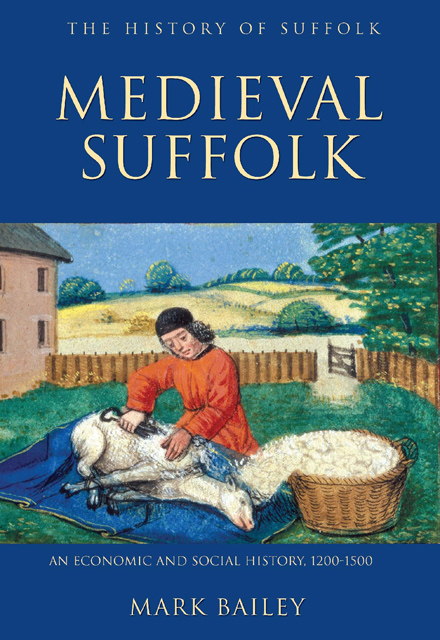Book contents
- Frontmatter
- Contents
- List of Plates
- List of Maps
- List of Tables
- Foreword
- Acknowledgements
- Note on Currency & Units of Measurement
- Abbreviations
- 1 Introduction
- 2 Landlords and their Estates, 1200–1349
- 3 Peasants and their Lifestyles, 1200–1349
- 4 The Agrarian Economy, 1200–1349
- 5 The Suffolk Landscape, 1200–1349
- 6 Towns and the Urban Environment
- 7 Commerce, Crafts and Industry
- 8 Pestilence, Rebellion and the Decline of Villeinage, 1349–1500
- 9 The Rural Economy, 1350–1500
- 10 ‘The World Turned Upside Down’: Rural Society, 1350–1500
- 11 Towns, Trade and Industry, 1350–1500
- 12 Conclusion
- Bibliography
- Index
4 - The Agrarian Economy, 1200–1349
Published online by Cambridge University Press: 15 March 2023
- Frontmatter
- Contents
- List of Plates
- List of Maps
- List of Tables
- Foreword
- Acknowledgements
- Note on Currency & Units of Measurement
- Abbreviations
- 1 Introduction
- 2 Landlords and their Estates, 1200–1349
- 3 Peasants and their Lifestyles, 1200–1349
- 4 The Agrarian Economy, 1200–1349
- 5 The Suffolk Landscape, 1200–1349
- 6 Towns and the Urban Environment
- 7 Commerce, Crafts and Industry
- 8 Pestilence, Rebellion and the Decline of Villeinage, 1349–1500
- 9 The Rural Economy, 1350–1500
- 10 ‘The World Turned Upside Down’: Rural Society, 1350–1500
- 11 Towns, Trade and Industry, 1350–1500
- 12 Conclusion
- Bibliography
- Index
Summary
Population and Settlement
The Domesday Survey of 1086 records nearly 20,000 landholders in Suffolk, suggesting a total population of around 100,000. The population certainly expanded over the next two centuries, although its exact magnitude is unknowable, because estimating medieval population levels is notoriously difficult on the scant evidence available. Dymond and Northeast reckon that it doubled between 1086 and c. 1300, although even higher rates of growth are evident in some places. For example, between 1086 and 1251 the landholding population of eight Suffolk manors belonging to the bishop of Ely increased by a factor of 2.5. The Lay Subsidy of 1327 lists 11,720 taxpayers in Suffolk, which crudely converts to a minimum population of about 180,000. Yet on the eve of the Black Death (1349) many Suffolk villages contained more residents than at any time before the mid-nineteenth century. Lidgate housed more people in the early fourteenth century than in 1801, and the population of Walsham (1,250) was not surpassed until 1851. Overall, the evidence encourages a more optimistic estimate of Suffolk’s medieval population, which may have peaked in the 1340s at around 225,000 inhabitants.
Although the actual population level of medieval Suffolk will always remain uncertain, we can gain a good sense of its relative density and distribution from the Domesday survey of 1086 and later tax assessments. In 1086 the population density of much of eastern England lay between five and ten landholders per square mile, compared with an average of thirteen in Suffolk (map 6), and the density of landholders in parts of central Suffolk, and around Ipswich, was among the highest in eleventh-century England. Lay subsidies from the early fourteenth century reveal that England possessed an average of 5.6 taxpayers per square mile, compared with nearly eight in Suffolk (map 7). At both dates, and especially 1086, Suffolk contained some of the most densely populated areas of England.
- Type
- Chapter
- Information
- Medieval SuffolkAn Economic and Social History, 1200-1500, pp. 67 - 89Publisher: Boydell & BrewerPrint publication year: 2007



